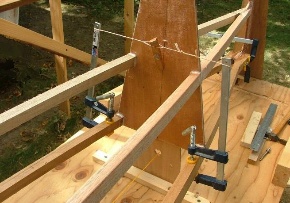
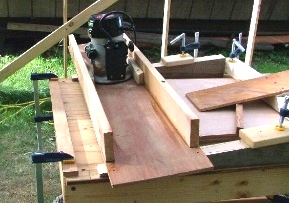
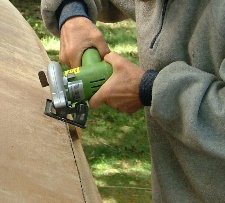



Bonding Pressures
Always consider bonding pressures with epoxy. Good to aim for 1.5–8 lbs/in² with pre-thickened epoxy, depending on viscosity of mixture used, which will in turn depend on amount of filler and ambient temperature. Cover the surface with your thickened epoxy, but especially if large, then pass a serrated edged plastic spreader over it to even it out. Then clamp until surplus starts to come out from all visible joints—but then, STOP. This is a gap-filling product, so while you need to assure complete wet contact, you should not squeeze it all out!
Look at these two examples. Although one cannot judge entirely from a picture as neither glue viscosity nor tightening force is apparent, perhaps one risks having too much pressure and another, not enough! A flat slab of concrete is very light when compared to the local force of a large G‑clamp, so need to have a real light touch when using this many! To achieve even 1.5 lbs/in², a flat laid 16" × 8" block would have to weigh 192 lbs—whereas a large, tight G‑clamp can easily create 500 lbs/in²! **. So for the latter, it's best to use a plywood pad under the clamping head to distribute the load and even then, do NOT over-tighten. We're dealing with a HUGE potential range here which therefore requires personal judgment for each application. The left hand image shows far too light a pressure, while the right-hand image shows potentially too much, so such clamps need to have fairly light tightening when that numerous.
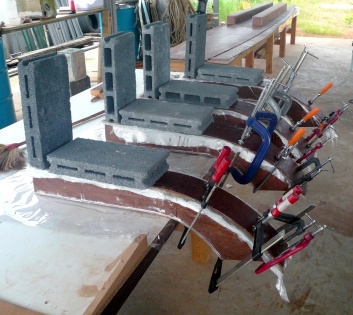 ** Just for reader info and interest, I checked the screw-geometry of a sturdy 5" cast-steel C-Clamp. The pressure pad advanced 0.375" with 4 turns of the screw. If we assume one applies most force at 1/2" from the end of the handle, that was at a 3" radius. So 4 turns gives this in applied distance.: 3.1416 x 6 x 4 = 75.4 inches. If we divide that by the screw advance (0.375), we can see that there is a 200:1 leverage in this case. So ignoring screw friction, 1lb applied with a finger at the end of the sliding handle, will give 200 lbs (!) at the pressure point of the clamp. So a good warning, to use screw clamps with care! (Note that lighter, more flexible clamps will not give quite the same pressure, as the frames tend to bend. .
** Just for reader info and interest, I checked the screw-geometry of a sturdy 5" cast-steel C-Clamp. The pressure pad advanced 0.375" with 4 turns of the screw. If we assume one applies most force at 1/2" from the end of the handle, that was at a 3" radius. So 4 turns gives this in applied distance.: 3.1416 x 6 x 4 = 75.4 inches. If we divide that by the screw advance (0.375), we can see that there is a 200:1 leverage in this case. So ignoring screw friction, 1lb applied with a finger at the end of the sliding handle, will give 200 lbs (!) at the pressure point of the clamp. So a good warning, to use screw clamps with care! (Note that lighter, more flexible clamps will not give quite the same pressure, as the frames tend to bend. .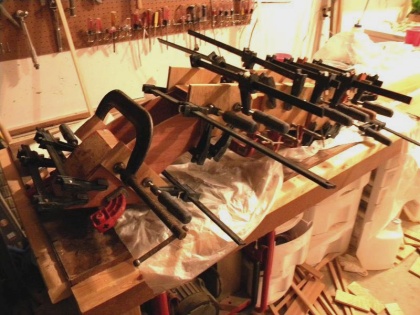
With heavy distribution pads, you don't need a large number of powerful clamps. Here's an example and the result.
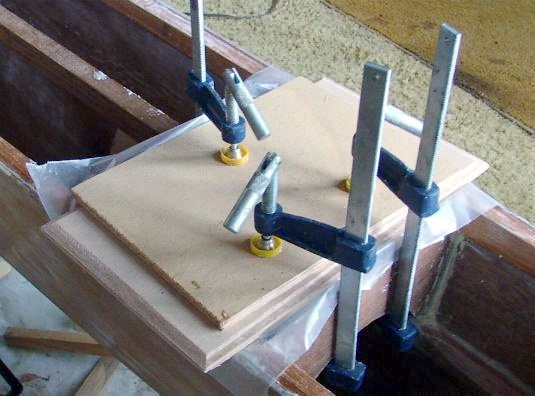
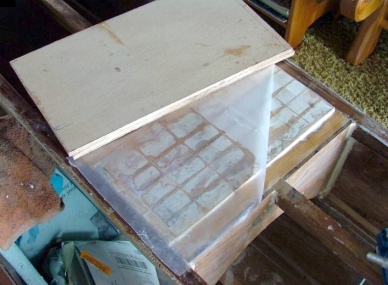
Another example can be made, more mathematically. Suppose we're to use a clamp pad of 4" × 4" (100 × 100). Then, using 3–4 lbs/in² as a target pressure, this would give 16 × 3 (or 16 × 4) as the clamp load required—namely, 48–64 lbs. Now, as this is about the range of load you could place on the pad, pressing down hard with your fingertips, you can see that screwing up a G-clamp very hard would easily exceed that figure. But a block of cement of 4" × 4" section would have to be about 4 ft (1.2 m) tall to give that same pressure! For myself, the use of concrete blocks can only work when you have the space to place them over a much smaller pad to concentrate the pressure. Placing a sheet of wax paper under the pad, prevents it bonding to the joint. (Of course, G-clamps are the same as C-clamps. I just think the 'G' is a better fit ;)
mike–2012
Read more Construction Tips & Techniques.
"New articles, comments and references will be added periodically as new questions are answered and other info comes in relative to this subject, so you're invited to revisit and participate." —webmaster
"See the Copyright Information & Legal Disclaimer page for copyright info and use of ANY part of this text or article"